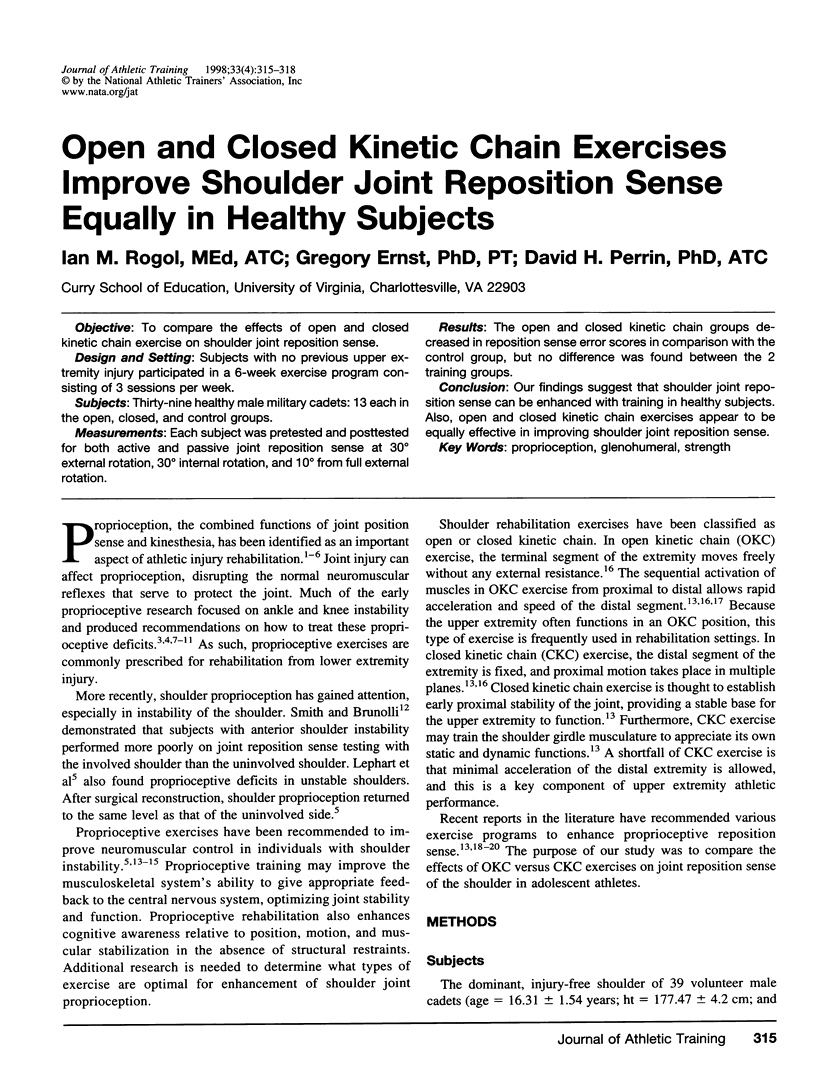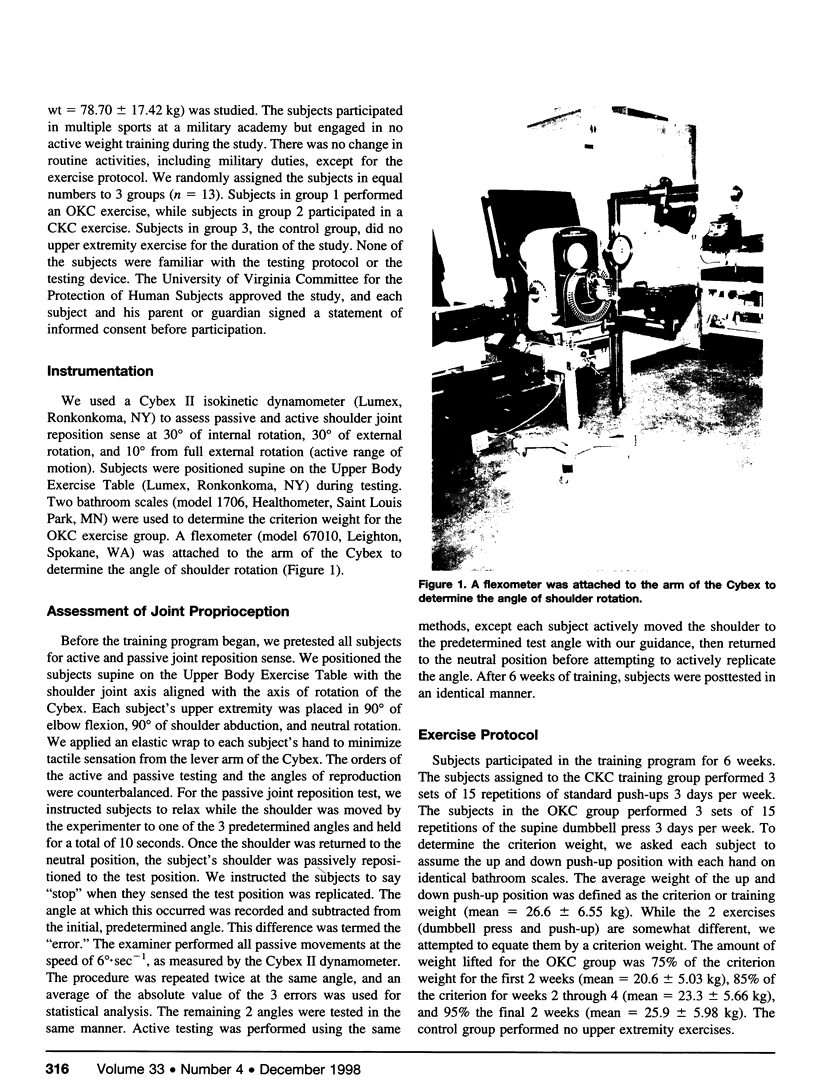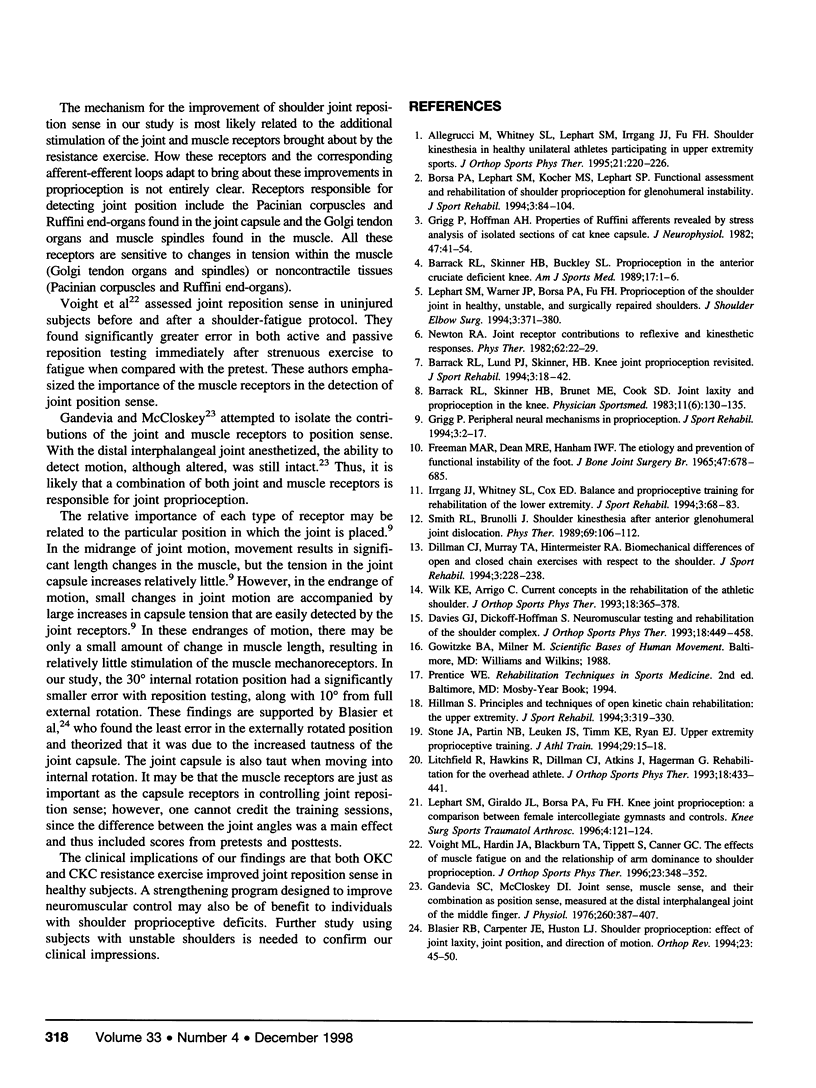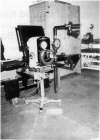Abstract
Objective:
To compare the effects of open and closed kinetic chain exercise on shoulder joint reposition sense.
Design and Setting:
Subjects with no previous upper extremity injury participated in a 6-week exercise program consisting of 3 sessions per week.
Subjects:
Thirty-nine healthy male military cadets: 13 each in the open, closed, and control groups.
Measurements:
Each subject was pretested and posttested for both active and passive joint reposition sense at 30° external rotation, 30° internal rotation, and 10° from full external rotation.
Results:
The open and closed kinetic chain groups de- creased in reposition sense error scores in comparison with the control group, but no difference was found between the 2 training groups.
Conclusion:
Our findings suggest that shoulder joint reposition sense can be enhanced with training in healthy subjects. Also, open and closed kinetic chain exercises appear to be equally effective in improving shoulder joint reposition sense.
Keywords: proprioception, glenohumeral, strength
Full text
PDF



Images in this article
Selected References
These references are in PubMed. This may not be the complete list of references from this article.
- Allegrucci M., Whitney S. L., Lephart S. M., Irrgang J. J., Fu F. H. Shoulder kinesthesia in healthy unilateral athletes participating in upper extremity sports. J Orthop Sports Phys Ther. 1995 Apr;21(4):220–226. doi: 10.2519/jospt.1995.21.4.220. [DOI] [PubMed] [Google Scholar]
- Barrack R. L., Skinner H. B., Buckley S. L. Proprioception in the anterior cruciate deficient knee. Am J Sports Med. 1989 Jan-Feb;17(1):1–6. doi: 10.1177/036354658901700101. [DOI] [PubMed] [Google Scholar]
- Blasier R. B., Carpenter J. E., Huston L. J. Shoulder proprioception. Effect of joint laxity, joint position, and direction of motion. Orthop Rev. 1994 Jan;23(1):45–50. [PubMed] [Google Scholar]
- Davies G. J., Dickoff-Hoffman S. Neuromuscular testing and rehabilitation of the shoulder complex. J Orthop Sports Phys Ther. 1993 Aug;18(2):449–458. doi: 10.2519/jospt.1993.18.2.449. [DOI] [PubMed] [Google Scholar]
- Freeman M. A., Dean M. R., Hanham I. W. The etiology and prevention of functional instability of the foot. J Bone Joint Surg Br. 1965 Nov;47(4):678–685. [PubMed] [Google Scholar]
- Gandevia S. C., McCloskey D. I. Joint sense, muscle sense, and their combination as position sense, measured at the distal interphalangeal joint of the middle finger. J Physiol. 1976 Sep;260(2):387–407. doi: 10.1113/jphysiol.1976.sp011521. [DOI] [PMC free article] [PubMed] [Google Scholar]
- Grigg P., Hoffman A. H. Properties of Ruffini afferents revealed by stress analysis of isolated sections of cat knee capsule. J Neurophysiol. 1982 Jan;47(1):41–54. doi: 10.1152/jn.1982.47.1.41. [DOI] [PubMed] [Google Scholar]
- Lephart S. M., Giraldo J. L., Borsa P. A., Fu F. H. Knee joint proprioception: a comparison between female intercollegiate gymnasts and controls. Knee Surg Sports Traumatol Arthrosc. 1996;4(2):121–124. doi: 10.1007/BF01477265. [DOI] [PubMed] [Google Scholar]
- Litchfield R., Hawkins R., Dillman C. J., Atkins J., Hagerman G. Rehabilitation for the overhead athlete. J Orthop Sports Phys Ther. 1993 Aug;18(2):433–441. doi: 10.2519/jospt.1993.18.2.433. [DOI] [PubMed] [Google Scholar]
- Newton R. A. Joint receptor contributions to reflexive and kinesthetic responses. Phys Ther. 1982 Jan;62(1):22–29. doi: 10.1093/ptj/62.1.22. [DOI] [PubMed] [Google Scholar]
- Partin N. B., Stone J. A., Ryan E. J., Lueken J. S., Timm K. E. Upper extremity proprioceptive training. J Athl Train. 1994 Mar;29(1):15–18. [PMC free article] [PubMed] [Google Scholar]
- Smith R. L., Brunolli J. Shoulder kinesthesia after anterior glenohumeral joint dislocation. Phys Ther. 1989 Feb;69(2):106–112. doi: 10.1093/ptj/69.2.106. [DOI] [PubMed] [Google Scholar]
- Voight M. L., Hardin J. A., Blackburn T. A., Tippett S., Canner G. C. The effects of muscle fatigue on and the relationship of arm dominance to shoulder proprioception. J Orthop Sports Phys Ther. 1996 Jun;23(6):348–352. doi: 10.2519/jospt.1996.23.6.348. [DOI] [PubMed] [Google Scholar]
- Wilk K. E., Arrigo C. Current concepts in the rehabilitation of the athletic shoulder. J Orthop Sports Phys Ther. 1993 Jul;18(1):365–378. doi: 10.2519/jospt.1993.18.1.365. [DOI] [PubMed] [Google Scholar]



